This list is of the Cultural Properties of Japan designated in the category of paintings (絵画, kaiga) for the Prefecture of Kanagawa. [1]
National Cultural Properties
As of 1 August 2019, fifty-one Important Cultural Properties (including six * National Treasures) have been designated, being of national significance. [2] [3] [4] [5]
| Property | Date | Municipality | Ownership | Comments | Image | Dimensions | Coordinates | Ref. |
|---|---|---|---|---|---|---|---|---|
| *
Rankei Dōryū, light colour on silk 絹本淡彩蘭溪道隆像 kenpon tansai Rankei Dōryū zō |
1271 | Kamakura |
Kenchō-ji (kept at the Kamakura Museum of National Treasures) |
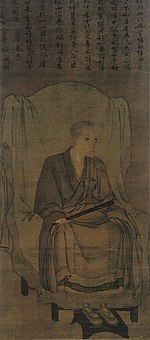 |
104.8 centimetres (41.3 in) by 46.4 centimetres (18.3 in) | 35°19′29″N 139°33′25″E / 35.324619°N 139.557014°E | [1] | |
| *Pictorial Biography of
Ippen Shōnin, colour on silk, by Hōgen Eni 絹本著色一遍上人絵伝〈法眼円伊筆/〉 kenpon chakushoku Ippen Shōnin e-den (Hōgen Eni hitsu) |
1299 | Fujisawa | Shōjōkō-ji | twelve scrolls |
 |
35°20′54″N 139°29′19″E / 35.348444°N 139.488667°E | [2] | |
| *
Hōjō Sanetoki, colour on silk * Hōjō Akitoki, colour on silk * Kanazawa Sadaaki, colour on silk * Kanazawa Tadamasa, colour on silk 絹本著色北条実時像 絹本著色北条顕時像 絹本著色 金沢貞顕像 絹本著色 金沢貞将像 kenpon chakushoku Hōjō Sanetoki zō kenpon chakushoku Hōjō Akitoki zō kenpon chakushoku Kanazawa Sadaaki zō kenpon chakushoku Kanazawa Tadamasa zō |
Kamakura period | Yokohama |
Shōmyō-ji (
称名寺) (kept at Kanazawa Bunko) |
four scrolls |

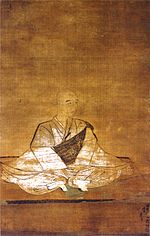
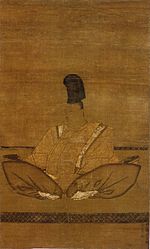
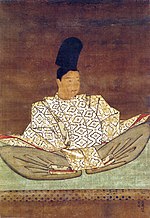 |
35°20′38″N 139°37′43″E / 35.343944°N 139.628712°E | [3] [4] [5] [6] | |
| *Ten Expediences, light colour on paper, by
Ike no Taiga *Ten Merits, light colour on paper, by Yosa Buson 紙本淡彩十便図〈池大雅筆/〉 紙本淡彩十宣図〈与謝蕪村筆/〉 shihon tansai jūben zu (Ike no Taiga hitsu) shihon tansai jugi zu (Yosa Buson hitsu) |
1771 | Kamakura |
Kawabata Yasunari Memorial Association (川端康成記念会) (kept at the Kawabata Yasunari Memorial Hall (川端康成記念館)) |
one album |
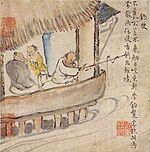
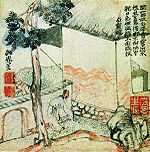 |
17.7 centimetres (7.0 in) by 17.7 centimetres (7.0 in) | 35°18′50″N 139°32′13″E / 35.313949°N 139.536842°E | [7] [8] |
| *Legends of the
Taima Mandala, colour on paper 紙本著色当麻曼荼羅縁起 shihon chakushoku Taima mandara engi |
Kamakura period | Kamakura |
Kōmyō-ji (kept at the Kamakura Museum of National Treasures) |
two emakimono |
 |
51.5 centimetres (20.3 in) by 796.7 centimetres (26 ft 1.7 in) and 689.8 centimetres (22 ft 7.6 in) | 35°19′29″N 139°33′25″E / 35.324619°N 139.557014°E | [9] |
| *Frozen Clouds, Sifted Snow, ink on paper, by
Uragami Gyokudō 紙本墨画凍雲篩雪図〈浦上玉堂筆/〉 shihon bokuga tōun shisetsu zu (Uragami Gyokudō hitsu) |
Edo period | Kamakura |
Kawabata Yasunari Memorial Association (川端康成記念会) (kept at the Kawabata Yasunari Memorial Hall (川端康成記念館)) |
 |
133.3 centimetres (52.5 in) by 56.6 centimetres (22.3 in) | 35°18′50″N 139°32′13″E / 35.313949°N 139.536842°E | [10] | |
|
Hōjō Sōun, light colour on silk 絹本淡彩北条早雲像 kenpon tansai Hōjō Sōun zō |
Muromachi period | Hakone | Sōun-ji ( 早雲寺) |
 |
35°13′48″N 139°06′13″E / 35.230078°N 139.103669°E | [11] | ||
|
Amida Nyorai, colour on silk 絹本著色阿弥陀如来像 kenpon chakushoku Amida Nyorai zō |
Kamakura period | Tokyo | Hōshin-ji (報身寺) (kept at Tokyo National Museum) |
 |
35°43′08″N 139°46′36″E / 35.718796°N 139.776564°E | [12] | ||
|
Ikō Shōnin, ink and light colour on paper 絹本著色 一向上人像 kenpon chakushoku Ikō Shōnin zō |
Kamakura period | Fujisawa | Shōjōkō-ji | 35°20′54″N 139°29′19″E / 35.348442°N 139.488647°E | [13] | |||
|
Kokūzō Bosatsu, colour on silk 絹本著色虚空蔵菩薩像 kenpon chakushoku Kokūzō Bosatsu zō |
Kamakura period | Kamakura |
Engaku-ji (kept at the Kamakura Museum of National Treasures) |
 |
35°19′29″N 139°33′25″E / 35.324619°N 139.557014°E | [14] | ||
| Five Hundred
Arhats, colour on silk 絹本著色五百羅漢像 kenpon chakushoku gohyaku rakan zō |
Yuan dynasty | Kamakura |
Engaku-ji (kept at the Kamakura Museum of National Treasures) |
thirty-three scrolls | 35°19′29″N 139°33′25″E / 35.324619°N 139.557014°E | [15] | ||
|
Emperor Go-Daigo, colour on silk 絹本著色後醍醐天皇御像 kenpon chakushoku Go-Daigo tennō mizō |
Nanboku-chō period | Fujisawa | Shōjōkō-ji |
 |
35°20′54″N 139°29′19″E / 35.348442°N 139.488647°E | [16] | ||
|
Shaka Triad, colour on silk 絹本著色釈迦三尊像 kenpon chakushoku Shaka Nyorai zō |
Southern Song | Kamakura |
Kenchō-ji (kept at the Kamakura Museum of National Treasures) |
 |
131.6 centimetres (51.8 in) by 82.8 centimetres (32.6 in) | 35°19′29″N 139°33′25″E / 35.324619°N 139.557014°E | [17] | |
| Ten Kings of Hell, colour on silk 絹本著色 十王図 kenpon chakushoku jū-ō zu |
Southern Song | Yokohama | Kanagawa Prefectural Museum of Cultural History | ten scrolls |
 |
35°26′57″N 139°38′10″E / 35.44922121°N 139.63609362°E | [18] | |
|
Twelve Heavenly Generals, colour on silk 絹本著色十二神将像 kenpon chakushoku jūni shinshō zō |
Kamakura period | Yokohama |
Shōmyō-ji (
称名寺) (kept at Kanazawa Bunko) |
twelve scrolls |

 |
35°20′38″N 139°37′43″E / 35.343944°N 139.628712°E | [19] | |
| Eighteen
Arhats and a Monk, colour on silk 絹本著色十八羅漢及僧像 kenpon chakushoku jūhachi rakan oyobi sō zō |
Kamakura period | Kamakura |
Kōmyō-ji (kept at the Kamakura Museum of National Treasures) |
nineteen scrolls | 120.0 centimetres (47.2 in) by 48.5 centimetres (19.1 in) | 35°19′29″N 139°33′25″E / 35.324619°N 139.557014°E | [20] | |
| Sixteen
Arhats, colour on silk 絹本著色十六羅漢像 kenpon chakushoku jūroku rakan zō |
Muromachi period | Kamakura |
Kenchō-ji (kept at the Kamakura Museum of National Treasures) |
eight scrolls |
 |
143.9 centimetres (56.7 in) by 83.0 centimetres (32.7 in) | 35°19′29″N 139°33′25″E / 35.324619°N 139.557014°E | [21] |
|
Keizan Jōkin, colour on silk 絹本著色紹瑾和尚像 kenpon chakushoku Shōkin Oshō zō |
1319 | Yokohama | Sōji-ji |
 |
89.2 centimetres (35.1 in) by 38.6 centimetres (15.2 in) | 35°18′14″N 139°33′16″E / 35.303824°N 139.554392°E | [22] | |
| Shinkai, colour on silk 絹本著色審海像 kenpon chakushoku Shinkai zō |
Kamakura period | Yokohama |
Shōmyō-ji (
称名寺) (kept at Kanazawa Bunko) |
35°20′38″N 139°37′43″E / 35.343944°N 139.628712°E | [23] | |||
| Wife of
Maeda Toshiie, colour on silk 絹本著色前田利家夫人像 kenpon chakushoku Maeda Toshiie fujin zō |
Momoyama period | Yokohama | Sōji-ji |
 |
101.1 centimetres (39.8 in) by 50.3 centimetres (19.8 in) | 35°18′14″N 139°33′16″E / 35.303824°N 139.554392°E | [24] | |
|
Daikaku Zenji, colour on silk 絹本著色大覚禅師像 kenpon chakushoku Daikaku Zenji zō |
Kamakura period | Kamakura |
Kenchō-ji (kept at the Kamakura Museum of National Treasures) |
alternatively dated to the Yuan [5] | 35°19′29″N 139°33′25″E / 35.324619°N 139.557014°E | [25] | ||
|
Daikaku Zenji, colour on silk 絹本著色大覚禅師像〈/経行像〉 kenpon chakushoku Daikaku Zenji zō (kyōgyō zō) |
Kamakura period | Kamakura |
Kenchō-ji (kept at the Kamakura Museum of National Treasures) |
" walking meditation portrait" | 35°19′29″N 139°33′25″E / 35.324619°N 139.557014°E | [26] | ||
| Portrait said to be of
Hōjō Saneyasu, colour on silk 絹本著色伝 北条実泰像 kenpon chakushoku den-Hōjō Saneyasu zō |
Kamakura period | Yokohama |
Shōmyō-ji (
称名寺) (kept at Kanazawa Bunko) |
 |
35°20′38″N 139°37′43″E / 35.343944°N 139.628712°E | [27] | ||
|
Taima Mandala, colour on silk 絹本著色当麻曼荼羅図 kenpon chakushoku Taima mandara zu |
Kamakura period | Kamakura |
Kōmyō-ji (kept at the Kamakura Museum of National Treasures) |
 |
147.6 centimetres (58.1 in) by 143.3 centimetres (56.4 in) | 35°19′29″N 139°33′25″E / 35.324619°N 139.557014°E | [28] | |
|
Ninshō, colour on silk 絹本著色忍性像 kenpon chakushoku Ninshō zō |
Kamakura period | Yokohama |
Shōmyō-ji (
称名寺) (kept at Kanazawa Bunko) |
 |
35°20′38″N 139°37′43″E / 35.343944°N 139.628712°E | [29] | ||
| Shian
Oshō, colour on silk 絹本著色之庵和尚像 kenpon chakushoku Shian Oshō zō |
1333 | Kamakura | Kigen-in (帰源院) (subtemple of Engaku-ji) (kept at the Kamakura Museum of National Treasures) |
 |
35°19′29″N 139°33′25″E / 35.324619°N 139.557014°E | [30] | ||
| Hooded
Jizō, colour on silk 絹本著色被帽地蔵菩薩像 kenpon chakushoku hibō Jizō bosatsu zō |
Goryeo | Kamakura | Engaku-ji | Goryeo Buddhist painting; alternatively ascribed to the Yuan [5] |
 |
239.4 centimetres (7 ft 10.3 in) by 130.0 centimetres (4 ft 3.2 in) | 35°20′12″N 139°32′52″E / 35.336781°N 139.547836°E | [31] |
| Bukkoku Kokushi, colour on silk 絹本著色仏光国師像 kenpon chakushoku Bukkoku Kokushi zō |
1284 | Kamakura |
Engaku-ji (kept at the Kamakura Museum of National Treasures) |
35°19′29″N 139°33′25″E / 35.324619°N 139.557014°E | [32] | |||
|
Buddha's
Parinirvana, colour on silk 絹本著色仏涅槃図 kenpon chakushoku Butsu nehan zu |
Kamakura period | Kamakura |
Engaku-ji (kept at the Kamakura Museum of National Treasures) |
35°19′29″N 139°33′25″E / 35.324619°N 139.557014°E | [33] | |||
|
Musō Kokushi, colour on silk 絹本著色夢窓国師像 kenpon chakushoku Musō Kokushi zō |
Kamakura period | Kamakura | Ōbai-in (黄梅院) (subtemple of Engaku-ji) (kept at the Kamakura Museum of National Treasures) |
 |
35°19′29″N 139°33′25″E / 35.324619°N 139.557014°E | [34] | ||
|
Kannon, ink on silk 絹本墨画観音像 kenpon bokuga Kannon zu |
Muromachi period | Kamakura |
Kenchō-ji (kept at the Kamakura Museum of National Treasures) |
thirty-two scrolls |
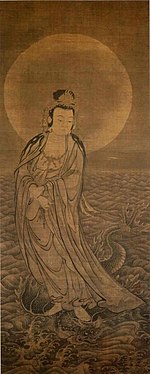
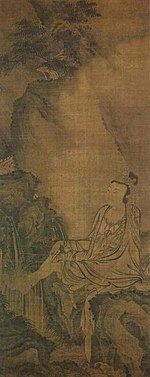
 |
128.5 centimetres (50.6 in) by 51.8 centimetres (20.4 in) | 35°19′29″N 139°33′25″E / 35.324619°N 139.557014°E | [35] |
|
Sixteen Arhats, ink and light colour on silk 絹本墨画淡彩十六羅漢像 kenpon bokuga tansai jūroku rakan zō |
Yuan dynasty | Yokohama |
Shōmyō-ji (
称名寺) (kept at Kanazawa Bunko) |
sixteen scrolls | 35°20′38″N 139°37′43″E / 35.343944°N 139.628712°E | [36] | ||
|
Shōki, light colour on paper, by Yamada Dōan 紙本淡彩鍾馗図〈山田道安筆/〉 shihon tansai Shōki zu (Yamada Dōan hitsu) |
Muromachi period | Kamakura |
Engaku-ji (kept at the Kamakura Museum of National Treasures) |
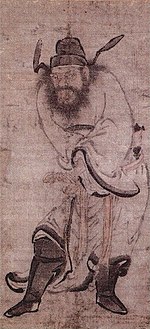 |
35°19′29″N 139°33′25″E / 35.324619°N 139.557014°E | [37] | ||
| Hōyaki Amida Engi, light colour on paper 紙本淡彩頬燒阿弥陀縁起 shihon tansai hōyaki Amida engi |
Kamakura period | Kamakura |
Kōsoku-ji (
光触寺) (kept at the Kamakura Museum of National Treasures) |
two hand scrolls | 35°19′29″N 139°33′25″E / 35.324619°N 139.557014°E | [38] | ||
|
Battabara, light colour on paper, by Sōen 紙本淡彩跋陀婆羅像〈宗淵筆/〉 shihon tansai Battabara zō (Sōen hitsu) |
Muromachi period | Kamakura |
Engaku-ji (kept at the Kamakura Museum of National Treasures) |
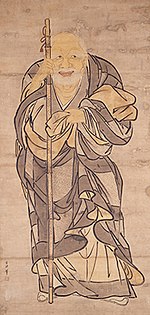 |
35°19′29″N 139°33′25″E / 35.324619°N 139.557014°E | [39] | ||
|
Gyokuin
Oshō, colour on paper 紙本著色 玉隠和尚像 shihon chakushoku Gyokuin Oshō zō |
Muromachi period | Kamakura |
Meigetsu-in (kept at the Kamakura Museum of National Treasures) |
35°19′29″N 139°33′25″E / 35.324619°N 139.557014°E | [40] | |||
| Fragment of the
Murasaki Shikibu Diary Ekotoba, colour on paper 紙本著色紫式部日記絵詞残闕 shihon chakushoku Murasaki Shikibu nikki ekotoba zanketsu |
Kamakura period | Kamakura | private | [41] | ||||
| Five
Pure Land Patriarchs, colour on paper (
Shandao) 紙紙本著色浄土五祖絵〈/(善導巻)〉 shihon chakushoku Jōdo goso-e (Zendō maki) |
Nanboku-chō period | Kamakura |
Kōmyō-ji (kept at the Kamakura Museum of National Treasures) |
one emakimono | 35°19′29″N 139°33′25″E / 35.324619°N 139.557014°E | [42] | ||
| Pictorial Biography of the Five
Pure Land Patriarchs, colour on paper 紙本著色浄土五祖絵伝 shihon chakushoku Jōdo goso eden |
1305 | Kamakura |
Kōmyō-ji (kept at the Kamakura Museum of National Treasures) |
one emakimono | 990.4 centimetres (32 ft 5.9 in) by 33.0 centimetres (13.0 in) | 35°19′29″N 139°33′25″E / 35.324619°N 139.557014°E | [43] | |
|
Devadatta, colour on paper 紙本著色提婆達多像 shihon chakushoku Daibadatta zō |
late Goryeo | Kamakura | Sōji-ji |
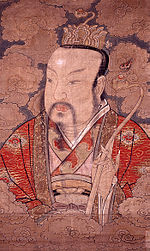 |
50.2 centimetres (19.8 in) by 91.6 centimetres (36.1 in) | 35°18′14″N 139°33′16″E / 35.303824°N 139.554392°E | [44] | |
| Legends of the
Hakone Gongen, colour on paper 紙本著色箱根権現縁起 shihon chakushoku Hakone Gongen engi |
Nanboku-chō period | Hakone | Hakone Jinja | one emakimono | 35°14′37″N 139°03′26″E / 35.243626°N 139.057267°E | [45] | ||
| Kikō Zenji, ink on paper 紙本墨画喜江禅師像 shihon bokuga Kikō Zenji zō |
Muromachi period | Kamakura |
Kenchō-ji (kept at the Kamakura Museum of National Treasures) |
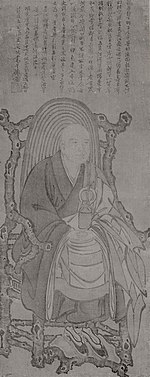 |
35°19′29″N 139°33′25″E / 35.324619°N 139.557014°E | [46] | ||
|
Miroku
Raigō, colour on wooden boards Pure Land of Miroku, colour on wooden boards 板絵著色弥勒来迎図 板絵著色弥勒浄土図 ita-e chakushoku Miroku raigō zu ita-e chakushoku Miroku jōdo zu |
Kamakura period | Yokohama | Shōmyō-ji ( 称名寺) |

 |
35°20′39″N 139°37′49″E / 35.344240°N 139.630333°E | [47] | ||
| Figures with Birds and Flowers, colour on paper by Tōshun, six-fold
byōbu 紙本著色花鳥人物図〈等春筆/六曲屏風(十一図)〉 shihon chakushoku kachō zu (Tōshun hitsu rokkyoku byōbu jūichi zu) |
Muromachi period | Kawasaki | private | pair of screens; eleven images | [48] | |||
| Seeing off a High Priest, Returning Home Beyond the Seas, light colour on paper 紙本淡彩送海東上人帰国図 shihon tansai sōkaitō shōnin kikoku zu |
c. 1194 ( Southern Song) | Taitō |
Tokiwayama Bunko (kept at Tokyo National Museum) |
inscribed by Zhong Tangjie (鍾唐傑) and Dou Congzhou (竇従周) |
 |
63.6 centimetres (25.0 in) by 36.3 centimetres (14.3 in) | 35°43′08″N 139°46′36″E / 35.718861°N 139.776554°E | [49] |
| Returning Home, light colour on paper 紙本淡彩帰郷省親図 shihon tansai kikyō shōshin zu |
Muromachi period | Taitō |
Tokiwayama Bunko (kept at Tokyo National Museum) |
inscribed by thirteen monks |
 |
83.9 centimetres (33.0 in) by 25.7 centimetres (10.1 in) | 35°43′08″N 139°46′36″E / 35.718861°N 139.776554°E | [50] |
|
Inuōmono, colour on paper with
gold ground, six-fold
byōbu 紙本金地著色犬追物図 六曲屏風 shihon tansai kinji chakushoku inuōmono zu rokkyoku byōbu |
Azuchi–Momoyama period | Kamakura | Tokiwayama Bunko | pair of screens | 35°18′57″N 139°32′34″E / 35.315749°N 139.542737°E | [51] | ||
|
Kakinomoto no Hitomaro, by Takuma Eiga, colour on silk 絹本著色柿本人麿像〈詫磨栄賀筆/〉 kenpon chakushoku Kakinomoto no Hitomaro zō (Takuma Eiga hitsu) |
1395 | Taitō |
Tokiwayama Bunko (kept at Tokyo National Museum) |
 |
84.3 centimetres (33.2 in) by 41.3 centimetres (16.3 in) | 35°43′08″N 139°46′36″E / 35.718861°N 139.776554°E | [52] | |
|
Shide, ink on paper 紙本墨画拾得図 shihon bokuga Jittoku zu |
Yuan dynasty | Taitō |
Tokiwayama Bunko (kept at Tokyo National Museum) |
inscribed by Huyan Jingfu (虎巌浄伏) |
 |
78.9 centimetres (31.1 in) by 32.4 centimetres (12.8 in) | 35°43′08″N 139°46′36″E / 35.718861°N 139.776554°E | [53] |
|
Crested Myna, ink on paper, by
Sesson 紙本墨画叭々鳥図〈雪村筆/〉 shihon bokuga hahachō zu (Sesson hitsu) |
C16 | Taitō |
Tokiwayama Bunko (kept at Tokyo National Museum) |
 |
35°43′08″N 139°46′36″E / 35.718861°N 139.776554°E | [54] | ||
| Eight-Letter
Monju Mandala, colour on silk 絹本著色八字文殊曼荼羅図 kenpon chakushoku hachi-ji Monju mandara zu |
Kamakura period | Kamakura | private | [55] |
Prefectural Cultural Properties
As of 1 August 2019, forty-two properties have been designated at a prefectural level. [4] [5] [6]
| Property | Date | Municipality | Ownership | Comments | Image | Dimensions | Coordinates | Ref. |
|---|---|---|---|---|---|---|---|---|
| Mountain Cherries, on wooden boards, by
Andō Hiroshige 板絵著色山桜図 安藤広重筆 ita-e chakushoku yamazakura zu Andō Hiroshige hitsu |
C19 | Yokohama | Senkoku-ji (泉谷寺) | eight panels | 35°30′22″N 139°35′07″E / 35.506000°N 139.585167°E | for all refs see [56] | ||
|
Senju Kannon with Twenty-Eight Attendants, colour on silk 絹本著色千手観音 二十八部衆像 kenpon chakushoku Senju Kannon nijūhachi-bushū zō |
late Kamakura period | Yokohama | Gumyō-ji ( 弘明寺) | 35°25′27″N 139°35′51″E / 35.424214°N 139.597410°E | ||||
|
Mandala of the Two Realms, colour on silk 絹本著色両界曼荼羅図 kenpon chakushoku ryōkai mandara zu |
late Kamakura period | Yokohama |
Hōkoku-ji (kept at Kanagawa Prefectural Museum of Cultural History) |
pair of scrolls | 35°26′57″N 139°38′10″E / 35.44922121°N 139.63609362°E | |||
|
Hachiman in Priestly Attire, colour on silk 絹本著色僧形八幡神像 kenpon chakushoku sōgyō Hachiman shinzō |
late Kamakura period | Yokohama |
Shōmyō-ji (
称名寺) (kept at Kanazawa Bunko) |
35°20′38″N 139°37′43″E / 35.343944°N 139.628712°E | ||||
| Portrait said to be of Nanzan Oshō, colour on silk 絹本著色伝南山和尚像 kenpon chakushoku den-Nanzan Oshō zō |
late Kamakura period | Yokohama |
Shōmyō-ji (
称名寺) (kept at Kanazawa Bunko) |
35°20′38″N 139°37′43″E / 35.343944°N 139.628712°E | ||||
| Portrait said to be of Reishi Oshō, colour on silk 絹本著色伝霊芝和尚像 kenpon chakushoku den-Reishi Oshō zō |
late Kamakura period | Yokohama |
Shōmyō-ji (
称名寺) (kept at Kanazawa Bunko) |
35°20′38″N 139°37′43″E / 35.343944°N 139.628712°E | ||||
|
Seed Syllable
Aizen Myōō, colour on silk 絹本著色種子愛染明王図 kenpon chakushoku shuji Aizen Myōō zō |
late Kamakura period | Yokohama |
Shōmyō-ji (
称名寺) (kept at Kanazawa Bunko) |
 |
35°20′38″N 139°37′43″E / 35.343944°N 139.628712°E | |||
|
Enma-ten Mandala, colour on silk 絹本著色 焔魔天曼荼羅図 kenpon chakushoku Enma-ten mandara zu |
late Kamakura period | Yokohama |
Shōmyō-ji (
称名寺) (kept at Kanazawa Bunko) |
35°20′38″N 139°37′43″E / 35.343944°N 139.628712°E | ||||
| Three Thousand Buddhas, colour on silk 絹本著色三千佛像 kenpon chakushoku sanzen Butsu zō |
Nanboku-chō period | Yokohama |
Shōmyō-ji (
称名寺) (kept at Kanazawa Bunko) |
35°20′38″N 139°37′43″E / 35.343944°N 139.628712°E | ||||
| Thousand Buddhas, colour on silk 絹本著色千体佛像 kenpon chakushoku sendai Butsu zō |
Nanboku-chō period | Yokohama |
Shōmyō-ji (
称名寺) (kept at Kanazawa Bunko) |
pair of scrolls | 35°20′38″N 139°37′43″E / 35.343944°N 139.628712°E | |||
| Flowers and Birds, colour on silk 絹本著色花鳥図 kenpon chakushoku kachō zu |
Ming | Kamakura |
Hōkoku-ji (kept at the Kamakura Museum of National Treasures) |
pair of scrolls | 35°19′29″N 139°33′25″E / 35.324667°N 139.557036°E | |||
| High Priest, colour on silk 絹本著色高僧像 kenpon chakushoku kōsō zō |
Nanboku-chō period | Yokohama | Shōmyō-ji ( 称名寺) | pair of scrolls | 35°20′39″N 139°37′49″E / 35.344240°N 139.630333°E | |||
|
Ippen Shōnin, ink and light colour on paper 紙本墨画淡彩一遍上人像 [清浄光寺] shihon bokuga tansai Ippen Shōnin zō |
Muromachi period | Fujisawa | Shōjōkō-ji | 35°20′54″N 139°29′19″E / 35.348442°N 139.488647°E | ||||
|
Nichiren Shōnin, colour on silk 絹本著色日蓮上人像 kenpon chakushoku Nichiren Shōnin zō |
Momoyama period | Kamakura | Jōei-ji (浄永寺) (kept at the Kamakura Museum of National Treasures) |
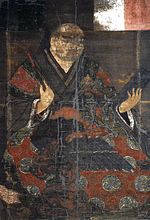 |
119 centimetres (47 in) by 76.5 centimetres (30.1 in) | 35°19′29″N 139°33′25″E / 35.324667°N 139.557036°E | ||
|
Daiitoku Myōō, colour on silk 絹本著色大威徳明王像 kenpon chakushoku Daiitoku Myōō zō |
late Kamakura period | Zushi | Jinmu-ji ( 神武寺) |
 |
35°18′15″N 139°36′22″E / 35.304049°N 139.606029°E | |||
|
Senju Kannon, colour on silk 絹本著色千手観音像 kenpon chakushoku Senju Kannon zō |
late Kamakura period | Zushi | Jinmu-ji ( 神武寺) | 35°18′15″N 139°36′22″E / 35.304049°N 139.606029°E | ||||
| Beautiful Women, colour on wooden boards,
ema by Utagawa Kunitsune 板絵著色歌川国経筆美人図絵馬 ita-e chakushoku Utagawa Kunitsune hitsu bijin zu ema |
1802 | Isehara | Hibita Jinja ( 比比多神社) |
 |
35°24′57″N 139°16′47″E / 35.415952°N 139.279738°E | |||
|
Hōjō Ujitsuna, colour on paper 紙本著色北條氏綱像 shihon chakushoku Hōjō Ujitsuna zō |
Momoyama period | Hakone | Sōun-ji ( 早雲寺) | 35°13′48″N 139°06′13″E / 35.230078°N 139.103669°E | ||||
|
Hōjō Ujiyasu, colour on paper 紙本著色北條氏康像 shihon chakushoku Hōjō Ujiyasu zō |
Edo period | Hakone | Sōun-ji ( 早雲寺) |
 |
35°13′48″N 139°06′13″E / 35.230078°N 139.103669°E | |||
| Small bird and
loquats, colour on paper 紙本著色枇杷小禽図 shihon chakushoku biwa shōkin zu |
Muromachi period | Hakone | Sōun-ji ( 早雲寺) |
 |
35°13′48″N 139°06′13″E / 35.230078°N 139.103669°E | |||
| Painted
Fusuma from the
Sōun-ji
Hondō, ink on paper 紙本墨画早雲寺本堂襖絵 shihon bokuga Sōunji hondō fusuma-e |
Edo period | Hakone | Sōun-ji ( 早雲寺) | thirty-eight panels | 35°13′48″N 139°06′13″E / 35.230078°N 139.103669°E | |||
|
Arhats, ink on paper 紙本墨画羅漢図 shihon bokuga rakan zu |
Edo period | Hakone | Sōun-ji ( 早雲寺) | three scrolls | 35°13′48″N 139°06′13″E / 35.230078°N 139.103669°E | |||
| Women spinning and weaving, ink and light colour on paper 紙本墨画淡彩機婦図 shihon bokuga tansai kifu zu |
late Muromachi/ Momoyama period | Hakone | Sōun-ji ( 早雲寺) | pair of scrolls |

 |
35°13′48″N 139°06′13″E / 35.230078°N 139.103669°E | ||
|
Sixteen Arhats, light colour on paper, by
Kusumi Morikage 紙本淡彩十六羅漢図 久隅守景筆 shihon tansai jūroku rakan zu Kusumi Morikage hitsu |
C17 | Sagamihara | Kōmyō-ji (光明寺) | 35°33′55″N 139°14′18″E / 35.565190°N 139.238461°E | ||||
|
Kumano
Gongen, colour on silk 絹本著色熊野権現影向図 kenpon chakushoku Kumano gongen yōgō zu |
Muromachi period | Sagamihara | Shōnen-ji (正念寺) | 35°36′17″N 139°08′01″E / 35.604747°N 139.133560°E |
Municipal Cultural Properties
As of 1 August 2019, a further one hundred and sixty-four properties have been designated as being of municipal importance. [4] [7]
See also
- Cultural Properties of Japan
- List of National Treasures of Japan (paintings)
- Japanese painting
- List of Historic Sites of Japan (Kanagawa)
- List of Cultural Properties of Japan - historical materials (Kanagawa)
References
- ^ "Cultural Properties for Future Generations". Agency for Cultural Affairs. Retrieved 1 September 2019.
- ^ 国宝・重要文化財 [Number of National Treasures and Important Cultural Properties by Prefecture] (in Japanese). Agency for Cultural Affairs. 1 July 2019. Retrieved 1 September 2019.
- ^ "Database of National Cultural Properties: 国宝・重要文化財(美術品)(絵画 神奈川県)" (in Japanese). Agency for Cultural Affairs. Archived from the original on 30 June 2019. Retrieved 26 August 2019.
- ^ a b c 文化財の指定等の状況 [Status of Cultural Properties] (PDF). Kanagawa Prefecture. 1 August 2019. Retrieved 1 September 2019.
- ^ a b c d 神奈川県文化財目録 [Catalogue of the Cultural Properties of Kanagawa Prefecture]. Kanagawa Prefecture. 1 May 2019. Retrieved 1 September 2019.
- ^ 都道府県別指定等文化財件数(都道府県分) [Number of Prefectural Cultural Properties by Prefecture] (in Japanese). Agency for Cultural Affairs. 1 May 2019. Retrieved 1 September 2019.
- ^ 都道府県別指定等文化財件数(市町村分) [Number of Municipal Cultural Properties by Prefecture] (in Japanese). Agency for Cultural Affairs. 1 May 2019. Retrieved 1 September 2019.
External links
- (in Japanese) Cultural Properties in Kanagawa Prefecture
This list is of the Cultural Properties of Japan designated in the category of paintings (絵画, kaiga) for the Prefecture of Kanagawa. [1]
National Cultural Properties
As of 1 August 2019, fifty-one Important Cultural Properties (including six * National Treasures) have been designated, being of national significance. [2] [3] [4] [5]
| Property | Date | Municipality | Ownership | Comments | Image | Dimensions | Coordinates | Ref. |
|---|---|---|---|---|---|---|---|---|
| *
Rankei Dōryū, light colour on silk 絹本淡彩蘭溪道隆像 kenpon tansai Rankei Dōryū zō |
1271 | Kamakura |
Kenchō-ji (kept at the Kamakura Museum of National Treasures) |
 |
104.8 centimetres (41.3 in) by 46.4 centimetres (18.3 in) | 35°19′29″N 139°33′25″E / 35.324619°N 139.557014°E | [1] | |
| *Pictorial Biography of
Ippen Shōnin, colour on silk, by Hōgen Eni 絹本著色一遍上人絵伝〈法眼円伊筆/〉 kenpon chakushoku Ippen Shōnin e-den (Hōgen Eni hitsu) |
1299 | Fujisawa | Shōjōkō-ji | twelve scrolls |
 |
35°20′54″N 139°29′19″E / 35.348444°N 139.488667°E | [2] | |
| *
Hōjō Sanetoki, colour on silk * Hōjō Akitoki, colour on silk * Kanazawa Sadaaki, colour on silk * Kanazawa Tadamasa, colour on silk 絹本著色北条実時像 絹本著色北条顕時像 絹本著色 金沢貞顕像 絹本著色 金沢貞将像 kenpon chakushoku Hōjō Sanetoki zō kenpon chakushoku Hōjō Akitoki zō kenpon chakushoku Kanazawa Sadaaki zō kenpon chakushoku Kanazawa Tadamasa zō |
Kamakura period | Yokohama |
Shōmyō-ji (
称名寺) (kept at Kanazawa Bunko) |
four scrolls |



 |
35°20′38″N 139°37′43″E / 35.343944°N 139.628712°E | [3] [4] [5] [6] | |
| *Ten Expediences, light colour on paper, by
Ike no Taiga *Ten Merits, light colour on paper, by Yosa Buson 紙本淡彩十便図〈池大雅筆/〉 紙本淡彩十宣図〈与謝蕪村筆/〉 shihon tansai jūben zu (Ike no Taiga hitsu) shihon tansai jugi zu (Yosa Buson hitsu) |
1771 | Kamakura |
Kawabata Yasunari Memorial Association (川端康成記念会) (kept at the Kawabata Yasunari Memorial Hall (川端康成記念館)) |
one album |

 |
17.7 centimetres (7.0 in) by 17.7 centimetres (7.0 in) | 35°18′50″N 139°32′13″E / 35.313949°N 139.536842°E | [7] [8] |
| *Legends of the
Taima Mandala, colour on paper 紙本著色当麻曼荼羅縁起 shihon chakushoku Taima mandara engi |
Kamakura period | Kamakura |
Kōmyō-ji (kept at the Kamakura Museum of National Treasures) |
two emakimono |
 |
51.5 centimetres (20.3 in) by 796.7 centimetres (26 ft 1.7 in) and 689.8 centimetres (22 ft 7.6 in) | 35°19′29″N 139°33′25″E / 35.324619°N 139.557014°E | [9] |
| *Frozen Clouds, Sifted Snow, ink on paper, by
Uragami Gyokudō 紙本墨画凍雲篩雪図〈浦上玉堂筆/〉 shihon bokuga tōun shisetsu zu (Uragami Gyokudō hitsu) |
Edo period | Kamakura |
Kawabata Yasunari Memorial Association (川端康成記念会) (kept at the Kawabata Yasunari Memorial Hall (川端康成記念館)) |
 |
133.3 centimetres (52.5 in) by 56.6 centimetres (22.3 in) | 35°18′50″N 139°32′13″E / 35.313949°N 139.536842°E | [10] | |
|
Hōjō Sōun, light colour on silk 絹本淡彩北条早雲像 kenpon tansai Hōjō Sōun zō |
Muromachi period | Hakone | Sōun-ji ( 早雲寺) |
 |
35°13′48″N 139°06′13″E / 35.230078°N 139.103669°E | [11] | ||
|
Amida Nyorai, colour on silk 絹本著色阿弥陀如来像 kenpon chakushoku Amida Nyorai zō |
Kamakura period | Tokyo | Hōshin-ji (報身寺) (kept at Tokyo National Museum) |
 |
35°43′08″N 139°46′36″E / 35.718796°N 139.776564°E | [12] | ||
|
Ikō Shōnin, ink and light colour on paper 絹本著色 一向上人像 kenpon chakushoku Ikō Shōnin zō |
Kamakura period | Fujisawa | Shōjōkō-ji | 35°20′54″N 139°29′19″E / 35.348442°N 139.488647°E | [13] | |||
|
Kokūzō Bosatsu, colour on silk 絹本著色虚空蔵菩薩像 kenpon chakushoku Kokūzō Bosatsu zō |
Kamakura period | Kamakura |
Engaku-ji (kept at the Kamakura Museum of National Treasures) |
 |
35°19′29″N 139°33′25″E / 35.324619°N 139.557014°E | [14] | ||
| Five Hundred
Arhats, colour on silk 絹本著色五百羅漢像 kenpon chakushoku gohyaku rakan zō |
Yuan dynasty | Kamakura |
Engaku-ji (kept at the Kamakura Museum of National Treasures) |
thirty-three scrolls | 35°19′29″N 139°33′25″E / 35.324619°N 139.557014°E | [15] | ||
|
Emperor Go-Daigo, colour on silk 絹本著色後醍醐天皇御像 kenpon chakushoku Go-Daigo tennō mizō |
Nanboku-chō period | Fujisawa | Shōjōkō-ji |
 |
35°20′54″N 139°29′19″E / 35.348442°N 139.488647°E | [16] | ||
|
Shaka Triad, colour on silk 絹本著色釈迦三尊像 kenpon chakushoku Shaka Nyorai zō |
Southern Song | Kamakura |
Kenchō-ji (kept at the Kamakura Museum of National Treasures) |
 |
131.6 centimetres (51.8 in) by 82.8 centimetres (32.6 in) | 35°19′29″N 139°33′25″E / 35.324619°N 139.557014°E | [17] | |
| Ten Kings of Hell, colour on silk 絹本著色 十王図 kenpon chakushoku jū-ō zu |
Southern Song | Yokohama | Kanagawa Prefectural Museum of Cultural History | ten scrolls |
 |
35°26′57″N 139°38′10″E / 35.44922121°N 139.63609362°E | [18] | |
|
Twelve Heavenly Generals, colour on silk 絹本著色十二神将像 kenpon chakushoku jūni shinshō zō |
Kamakura period | Yokohama |
Shōmyō-ji (
称名寺) (kept at Kanazawa Bunko) |
twelve scrolls |

 |
35°20′38″N 139°37′43″E / 35.343944°N 139.628712°E | [19] | |
| Eighteen
Arhats and a Monk, colour on silk 絹本著色十八羅漢及僧像 kenpon chakushoku jūhachi rakan oyobi sō zō |
Kamakura period | Kamakura |
Kōmyō-ji (kept at the Kamakura Museum of National Treasures) |
nineteen scrolls | 120.0 centimetres (47.2 in) by 48.5 centimetres (19.1 in) | 35°19′29″N 139°33′25″E / 35.324619°N 139.557014°E | [20] | |
| Sixteen
Arhats, colour on silk 絹本著色十六羅漢像 kenpon chakushoku jūroku rakan zō |
Muromachi period | Kamakura |
Kenchō-ji (kept at the Kamakura Museum of National Treasures) |
eight scrolls |
 |
143.9 centimetres (56.7 in) by 83.0 centimetres (32.7 in) | 35°19′29″N 139°33′25″E / 35.324619°N 139.557014°E | [21] |
|
Keizan Jōkin, colour on silk 絹本著色紹瑾和尚像 kenpon chakushoku Shōkin Oshō zō |
1319 | Yokohama | Sōji-ji |
 |
89.2 centimetres (35.1 in) by 38.6 centimetres (15.2 in) | 35°18′14″N 139°33′16″E / 35.303824°N 139.554392°E | [22] | |
| Shinkai, colour on silk 絹本著色審海像 kenpon chakushoku Shinkai zō |
Kamakura period | Yokohama |
Shōmyō-ji (
称名寺) (kept at Kanazawa Bunko) |
35°20′38″N 139°37′43″E / 35.343944°N 139.628712°E | [23] | |||
| Wife of
Maeda Toshiie, colour on silk 絹本著色前田利家夫人像 kenpon chakushoku Maeda Toshiie fujin zō |
Momoyama period | Yokohama | Sōji-ji |
 |
101.1 centimetres (39.8 in) by 50.3 centimetres (19.8 in) | 35°18′14″N 139°33′16″E / 35.303824°N 139.554392°E | [24] | |
|
Daikaku Zenji, colour on silk 絹本著色大覚禅師像 kenpon chakushoku Daikaku Zenji zō |
Kamakura period | Kamakura |
Kenchō-ji (kept at the Kamakura Museum of National Treasures) |
alternatively dated to the Yuan [5] | 35°19′29″N 139°33′25″E / 35.324619°N 139.557014°E | [25] | ||
|
Daikaku Zenji, colour on silk 絹本著色大覚禅師像〈/経行像〉 kenpon chakushoku Daikaku Zenji zō (kyōgyō zō) |
Kamakura period | Kamakura |
Kenchō-ji (kept at the Kamakura Museum of National Treasures) |
" walking meditation portrait" | 35°19′29″N 139°33′25″E / 35.324619°N 139.557014°E | [26] | ||
| Portrait said to be of
Hōjō Saneyasu, colour on silk 絹本著色伝 北条実泰像 kenpon chakushoku den-Hōjō Saneyasu zō |
Kamakura period | Yokohama |
Shōmyō-ji (
称名寺) (kept at Kanazawa Bunko) |
 |
35°20′38″N 139°37′43″E / 35.343944°N 139.628712°E | [27] | ||
|
Taima Mandala, colour on silk 絹本著色当麻曼荼羅図 kenpon chakushoku Taima mandara zu |
Kamakura period | Kamakura |
Kōmyō-ji (kept at the Kamakura Museum of National Treasures) |
 |
147.6 centimetres (58.1 in) by 143.3 centimetres (56.4 in) | 35°19′29″N 139°33′25″E / 35.324619°N 139.557014°E | [28] | |
|
Ninshō, colour on silk 絹本著色忍性像 kenpon chakushoku Ninshō zō |
Kamakura period | Yokohama |
Shōmyō-ji (
称名寺) (kept at Kanazawa Bunko) |
 |
35°20′38″N 139°37′43″E / 35.343944°N 139.628712°E | [29] | ||
| Shian
Oshō, colour on silk 絹本著色之庵和尚像 kenpon chakushoku Shian Oshō zō |
1333 | Kamakura | Kigen-in (帰源院) (subtemple of Engaku-ji) (kept at the Kamakura Museum of National Treasures) |
 |
35°19′29″N 139°33′25″E / 35.324619°N 139.557014°E | [30] | ||
| Hooded
Jizō, colour on silk 絹本著色被帽地蔵菩薩像 kenpon chakushoku hibō Jizō bosatsu zō |
Goryeo | Kamakura | Engaku-ji | Goryeo Buddhist painting; alternatively ascribed to the Yuan [5] |
 |
239.4 centimetres (7 ft 10.3 in) by 130.0 centimetres (4 ft 3.2 in) | 35°20′12″N 139°32′52″E / 35.336781°N 139.547836°E | [31] |
| Bukkoku Kokushi, colour on silk 絹本著色仏光国師像 kenpon chakushoku Bukkoku Kokushi zō |
1284 | Kamakura |
Engaku-ji (kept at the Kamakura Museum of National Treasures) |
35°19′29″N 139°33′25″E / 35.324619°N 139.557014°E | [32] | |||
|
Buddha's
Parinirvana, colour on silk 絹本著色仏涅槃図 kenpon chakushoku Butsu nehan zu |
Kamakura period | Kamakura |
Engaku-ji (kept at the Kamakura Museum of National Treasures) |
35°19′29″N 139°33′25″E / 35.324619°N 139.557014°E | [33] | |||
|
Musō Kokushi, colour on silk 絹本著色夢窓国師像 kenpon chakushoku Musō Kokushi zō |
Kamakura period | Kamakura | Ōbai-in (黄梅院) (subtemple of Engaku-ji) (kept at the Kamakura Museum of National Treasures) |
 |
35°19′29″N 139°33′25″E / 35.324619°N 139.557014°E | [34] | ||
|
Kannon, ink on silk 絹本墨画観音像 kenpon bokuga Kannon zu |
Muromachi period | Kamakura |
Kenchō-ji (kept at the Kamakura Museum of National Treasures) |
thirty-two scrolls |


 |
128.5 centimetres (50.6 in) by 51.8 centimetres (20.4 in) | 35°19′29″N 139°33′25″E / 35.324619°N 139.557014°E | [35] |
|
Sixteen Arhats, ink and light colour on silk 絹本墨画淡彩十六羅漢像 kenpon bokuga tansai jūroku rakan zō |
Yuan dynasty | Yokohama |
Shōmyō-ji (
称名寺) (kept at Kanazawa Bunko) |
sixteen scrolls | 35°20′38″N 139°37′43″E / 35.343944°N 139.628712°E | [36] | ||
|
Shōki, light colour on paper, by Yamada Dōan 紙本淡彩鍾馗図〈山田道安筆/〉 shihon tansai Shōki zu (Yamada Dōan hitsu) |
Muromachi period | Kamakura |
Engaku-ji (kept at the Kamakura Museum of National Treasures) |
 |
35°19′29″N 139°33′25″E / 35.324619°N 139.557014°E | [37] | ||
| Hōyaki Amida Engi, light colour on paper 紙本淡彩頬燒阿弥陀縁起 shihon tansai hōyaki Amida engi |
Kamakura period | Kamakura |
Kōsoku-ji (
光触寺) (kept at the Kamakura Museum of National Treasures) |
two hand scrolls | 35°19′29″N 139°33′25″E / 35.324619°N 139.557014°E | [38] | ||
|
Battabara, light colour on paper, by Sōen 紙本淡彩跋陀婆羅像〈宗淵筆/〉 shihon tansai Battabara zō (Sōen hitsu) |
Muromachi period | Kamakura |
Engaku-ji (kept at the Kamakura Museum of National Treasures) |
 |
35°19′29″N 139°33′25″E / 35.324619°N 139.557014°E | [39] | ||
|
Gyokuin
Oshō, colour on paper 紙本著色 玉隠和尚像 shihon chakushoku Gyokuin Oshō zō |
Muromachi period | Kamakura |
Meigetsu-in (kept at the Kamakura Museum of National Treasures) |
35°19′29″N 139°33′25″E / 35.324619°N 139.557014°E | [40] | |||
| Fragment of the
Murasaki Shikibu Diary Ekotoba, colour on paper 紙本著色紫式部日記絵詞残闕 shihon chakushoku Murasaki Shikibu nikki ekotoba zanketsu |
Kamakura period | Kamakura | private | [41] | ||||
| Five
Pure Land Patriarchs, colour on paper (
Shandao) 紙紙本著色浄土五祖絵〈/(善導巻)〉 shihon chakushoku Jōdo goso-e (Zendō maki) |
Nanboku-chō period | Kamakura |
Kōmyō-ji (kept at the Kamakura Museum of National Treasures) |
one emakimono | 35°19′29″N 139°33′25″E / 35.324619°N 139.557014°E | [42] | ||
| Pictorial Biography of the Five
Pure Land Patriarchs, colour on paper 紙本著色浄土五祖絵伝 shihon chakushoku Jōdo goso eden |
1305 | Kamakura |
Kōmyō-ji (kept at the Kamakura Museum of National Treasures) |
one emakimono | 990.4 centimetres (32 ft 5.9 in) by 33.0 centimetres (13.0 in) | 35°19′29″N 139°33′25″E / 35.324619°N 139.557014°E | [43] | |
|
Devadatta, colour on paper 紙本著色提婆達多像 shihon chakushoku Daibadatta zō |
late Goryeo | Kamakura | Sōji-ji |
 |
50.2 centimetres (19.8 in) by 91.6 centimetres (36.1 in) | 35°18′14″N 139°33′16″E / 35.303824°N 139.554392°E | [44] | |
| Legends of the
Hakone Gongen, colour on paper 紙本著色箱根権現縁起 shihon chakushoku Hakone Gongen engi |
Nanboku-chō period | Hakone | Hakone Jinja | one emakimono | 35°14′37″N 139°03′26″E / 35.243626°N 139.057267°E | [45] | ||
| Kikō Zenji, ink on paper 紙本墨画喜江禅師像 shihon bokuga Kikō Zenji zō |
Muromachi period | Kamakura |
Kenchō-ji (kept at the Kamakura Museum of National Treasures) |
 |
35°19′29″N 139°33′25″E / 35.324619°N 139.557014°E | [46] | ||
|
Miroku
Raigō, colour on wooden boards Pure Land of Miroku, colour on wooden boards 板絵著色弥勒来迎図 板絵著色弥勒浄土図 ita-e chakushoku Miroku raigō zu ita-e chakushoku Miroku jōdo zu |
Kamakura period | Yokohama | Shōmyō-ji ( 称名寺) |

 |
35°20′39″N 139°37′49″E / 35.344240°N 139.630333°E | [47] | ||
| Figures with Birds and Flowers, colour on paper by Tōshun, six-fold
byōbu 紙本著色花鳥人物図〈等春筆/六曲屏風(十一図)〉 shihon chakushoku kachō zu (Tōshun hitsu rokkyoku byōbu jūichi zu) |
Muromachi period | Kawasaki | private | pair of screens; eleven images | [48] | |||
| Seeing off a High Priest, Returning Home Beyond the Seas, light colour on paper 紙本淡彩送海東上人帰国図 shihon tansai sōkaitō shōnin kikoku zu |
c. 1194 ( Southern Song) | Taitō |
Tokiwayama Bunko (kept at Tokyo National Museum) |
inscribed by Zhong Tangjie (鍾唐傑) and Dou Congzhou (竇従周) |
 |
63.6 centimetres (25.0 in) by 36.3 centimetres (14.3 in) | 35°43′08″N 139°46′36″E / 35.718861°N 139.776554°E | [49] |
| Returning Home, light colour on paper 紙本淡彩帰郷省親図 shihon tansai kikyō shōshin zu |
Muromachi period | Taitō |
Tokiwayama Bunko (kept at Tokyo National Museum) |
inscribed by thirteen monks |
 |
83.9 centimetres (33.0 in) by 25.7 centimetres (10.1 in) | 35°43′08″N 139°46′36″E / 35.718861°N 139.776554°E | [50] |
|
Inuōmono, colour on paper with
gold ground, six-fold
byōbu 紙本金地著色犬追物図 六曲屏風 shihon tansai kinji chakushoku inuōmono zu rokkyoku byōbu |
Azuchi–Momoyama period | Kamakura | Tokiwayama Bunko | pair of screens | 35°18′57″N 139°32′34″E / 35.315749°N 139.542737°E | [51] | ||
|
Kakinomoto no Hitomaro, by Takuma Eiga, colour on silk 絹本著色柿本人麿像〈詫磨栄賀筆/〉 kenpon chakushoku Kakinomoto no Hitomaro zō (Takuma Eiga hitsu) |
1395 | Taitō |
Tokiwayama Bunko (kept at Tokyo National Museum) |
 |
84.3 centimetres (33.2 in) by 41.3 centimetres (16.3 in) | 35°43′08″N 139°46′36″E / 35.718861°N 139.776554°E | [52] | |
|
Shide, ink on paper 紙本墨画拾得図 shihon bokuga Jittoku zu |
Yuan dynasty | Taitō |
Tokiwayama Bunko (kept at Tokyo National Museum) |
inscribed by Huyan Jingfu (虎巌浄伏) |
 |
78.9 centimetres (31.1 in) by 32.4 centimetres (12.8 in) | 35°43′08″N 139°46′36″E / 35.718861°N 139.776554°E | [53] |
|
Crested Myna, ink on paper, by
Sesson 紙本墨画叭々鳥図〈雪村筆/〉 shihon bokuga hahachō zu (Sesson hitsu) |
C16 | Taitō |
Tokiwayama Bunko (kept at Tokyo National Museum) |
 |
35°43′08″N 139°46′36″E / 35.718861°N 139.776554°E | [54] | ||
| Eight-Letter
Monju Mandala, colour on silk 絹本著色八字文殊曼荼羅図 kenpon chakushoku hachi-ji Monju mandara zu |
Kamakura period | Kamakura | private | [55] |
Prefectural Cultural Properties
As of 1 August 2019, forty-two properties have been designated at a prefectural level. [4] [5] [6]
| Property | Date | Municipality | Ownership | Comments | Image | Dimensions | Coordinates | Ref. |
|---|---|---|---|---|---|---|---|---|
| Mountain Cherries, on wooden boards, by
Andō Hiroshige 板絵著色山桜図 安藤広重筆 ita-e chakushoku yamazakura zu Andō Hiroshige hitsu |
C19 | Yokohama | Senkoku-ji (泉谷寺) | eight panels | 35°30′22″N 139°35′07″E / 35.506000°N 139.585167°E | for all refs see [56] | ||
|
Senju Kannon with Twenty-Eight Attendants, colour on silk 絹本著色千手観音 二十八部衆像 kenpon chakushoku Senju Kannon nijūhachi-bushū zō |
late Kamakura period | Yokohama | Gumyō-ji ( 弘明寺) | 35°25′27″N 139°35′51″E / 35.424214°N 139.597410°E | ||||
|
Mandala of the Two Realms, colour on silk 絹本著色両界曼荼羅図 kenpon chakushoku ryōkai mandara zu |
late Kamakura period | Yokohama |
Hōkoku-ji (kept at Kanagawa Prefectural Museum of Cultural History) |
pair of scrolls | 35°26′57″N 139°38′10″E / 35.44922121°N 139.63609362°E | |||
|
Hachiman in Priestly Attire, colour on silk 絹本著色僧形八幡神像 kenpon chakushoku sōgyō Hachiman shinzō |
late Kamakura period | Yokohama |
Shōmyō-ji (
称名寺) (kept at Kanazawa Bunko) |
35°20′38″N 139°37′43″E / 35.343944°N 139.628712°E | ||||
| Portrait said to be of Nanzan Oshō, colour on silk 絹本著色伝南山和尚像 kenpon chakushoku den-Nanzan Oshō zō |
late Kamakura period | Yokohama |
Shōmyō-ji (
称名寺) (kept at Kanazawa Bunko) |
35°20′38″N 139°37′43″E / 35.343944°N 139.628712°E | ||||
| Portrait said to be of Reishi Oshō, colour on silk 絹本著色伝霊芝和尚像 kenpon chakushoku den-Reishi Oshō zō |
late Kamakura period | Yokohama |
Shōmyō-ji (
称名寺) (kept at Kanazawa Bunko) |
35°20′38″N 139°37′43″E / 35.343944°N 139.628712°E | ||||
|
Seed Syllable
Aizen Myōō, colour on silk 絹本著色種子愛染明王図 kenpon chakushoku shuji Aizen Myōō zō |
late Kamakura period | Yokohama |
Shōmyō-ji (
称名寺) (kept at Kanazawa Bunko) |
 |
35°20′38″N 139°37′43″E / 35.343944°N 139.628712°E | |||
|
Enma-ten Mandala, colour on silk 絹本著色 焔魔天曼荼羅図 kenpon chakushoku Enma-ten mandara zu |
late Kamakura period | Yokohama |
Shōmyō-ji (
称名寺) (kept at Kanazawa Bunko) |
35°20′38″N 139°37′43″E / 35.343944°N 139.628712°E | ||||
| Three Thousand Buddhas, colour on silk 絹本著色三千佛像 kenpon chakushoku sanzen Butsu zō |
Nanboku-chō period | Yokohama |
Shōmyō-ji (
称名寺) (kept at Kanazawa Bunko) |
35°20′38″N 139°37′43″E / 35.343944°N 139.628712°E | ||||
| Thousand Buddhas, colour on silk 絹本著色千体佛像 kenpon chakushoku sendai Butsu zō |
Nanboku-chō period | Yokohama |
Shōmyō-ji (
称名寺) (kept at Kanazawa Bunko) |
pair of scrolls | 35°20′38″N 139°37′43″E / 35.343944°N 139.628712°E | |||
| Flowers and Birds, colour on silk 絹本著色花鳥図 kenpon chakushoku kachō zu |
Ming | Kamakura |
Hōkoku-ji (kept at the Kamakura Museum of National Treasures) |
pair of scrolls | 35°19′29″N 139°33′25″E / 35.324667°N 139.557036°E | |||
| High Priest, colour on silk 絹本著色高僧像 kenpon chakushoku kōsō zō |
Nanboku-chō period | Yokohama | Shōmyō-ji ( 称名寺) | pair of scrolls | 35°20′39″N 139°37′49″E / 35.344240°N 139.630333°E | |||
|
Ippen Shōnin, ink and light colour on paper 紙本墨画淡彩一遍上人像 [清浄光寺] shihon bokuga tansai Ippen Shōnin zō |
Muromachi period | Fujisawa | Shōjōkō-ji | 35°20′54″N 139°29′19″E / 35.348442°N 139.488647°E | ||||
|
Nichiren Shōnin, colour on silk 絹本著色日蓮上人像 kenpon chakushoku Nichiren Shōnin zō |
Momoyama period | Kamakura | Jōei-ji (浄永寺) (kept at the Kamakura Museum of National Treasures) |
 |
119 centimetres (47 in) by 76.5 centimetres (30.1 in) | 35°19′29″N 139°33′25″E / 35.324667°N 139.557036°E | ||
|
Daiitoku Myōō, colour on silk 絹本著色大威徳明王像 kenpon chakushoku Daiitoku Myōō zō |
late Kamakura period | Zushi | Jinmu-ji ( 神武寺) |
 |
35°18′15″N 139°36′22″E / 35.304049°N 139.606029°E | |||
|
Senju Kannon, colour on silk 絹本著色千手観音像 kenpon chakushoku Senju Kannon zō |
late Kamakura period | Zushi | Jinmu-ji ( 神武寺) | 35°18′15″N 139°36′22″E / 35.304049°N 139.606029°E | ||||
| Beautiful Women, colour on wooden boards,
ema by Utagawa Kunitsune 板絵著色歌川国経筆美人図絵馬 ita-e chakushoku Utagawa Kunitsune hitsu bijin zu ema |
1802 | Isehara | Hibita Jinja ( 比比多神社) |
 |
35°24′57″N 139°16′47″E / 35.415952°N 139.279738°E | |||
|
Hōjō Ujitsuna, colour on paper 紙本著色北條氏綱像 shihon chakushoku Hōjō Ujitsuna zō |
Momoyama period | Hakone | Sōun-ji ( 早雲寺) | 35°13′48″N 139°06′13″E / 35.230078°N 139.103669°E | ||||
|
Hōjō Ujiyasu, colour on paper 紙本著色北條氏康像 shihon chakushoku Hōjō Ujiyasu zō |
Edo period | Hakone | Sōun-ji ( 早雲寺) |
 |
35°13′48″N 139°06′13″E / 35.230078°N 139.103669°E | |||
| Small bird and
loquats, colour on paper 紙本著色枇杷小禽図 shihon chakushoku biwa shōkin zu |
Muromachi period | Hakone | Sōun-ji ( 早雲寺) |
 |
35°13′48″N 139°06′13″E / 35.230078°N 139.103669°E | |||
| Painted
Fusuma from the
Sōun-ji
Hondō, ink on paper 紙本墨画早雲寺本堂襖絵 shihon bokuga Sōunji hondō fusuma-e |
Edo period | Hakone | Sōun-ji ( 早雲寺) | thirty-eight panels | 35°13′48″N 139°06′13″E / 35.230078°N 139.103669°E | |||
|
Arhats, ink on paper 紙本墨画羅漢図 shihon bokuga rakan zu |
Edo period | Hakone | Sōun-ji ( 早雲寺) | three scrolls | 35°13′48″N 139°06′13″E / 35.230078°N 139.103669°E | |||
| Women spinning and weaving, ink and light colour on paper 紙本墨画淡彩機婦図 shihon bokuga tansai kifu zu |
late Muromachi/ Momoyama period | Hakone | Sōun-ji ( 早雲寺) | pair of scrolls |

 |
35°13′48″N 139°06′13″E / 35.230078°N 139.103669°E | ||
|
Sixteen Arhats, light colour on paper, by
Kusumi Morikage 紙本淡彩十六羅漢図 久隅守景筆 shihon tansai jūroku rakan zu Kusumi Morikage hitsu |
C17 | Sagamihara | Kōmyō-ji (光明寺) | 35°33′55″N 139°14′18″E / 35.565190°N 139.238461°E | ||||
|
Kumano
Gongen, colour on silk 絹本著色熊野権現影向図 kenpon chakushoku Kumano gongen yōgō zu |
Muromachi period | Sagamihara | Shōnen-ji (正念寺) | 35°36′17″N 139°08′01″E / 35.604747°N 139.133560°E |
Municipal Cultural Properties
As of 1 August 2019, a further one hundred and sixty-four properties have been designated as being of municipal importance. [4] [7]
See also
- Cultural Properties of Japan
- List of National Treasures of Japan (paintings)
- Japanese painting
- List of Historic Sites of Japan (Kanagawa)
- List of Cultural Properties of Japan - historical materials (Kanagawa)
References
- ^ "Cultural Properties for Future Generations". Agency for Cultural Affairs. Retrieved 1 September 2019.
- ^ 国宝・重要文化財 [Number of National Treasures and Important Cultural Properties by Prefecture] (in Japanese). Agency for Cultural Affairs. 1 July 2019. Retrieved 1 September 2019.
- ^ "Database of National Cultural Properties: 国宝・重要文化財(美術品)(絵画 神奈川県)" (in Japanese). Agency for Cultural Affairs. Archived from the original on 30 June 2019. Retrieved 26 August 2019.
- ^ a b c 文化財の指定等の状況 [Status of Cultural Properties] (PDF). Kanagawa Prefecture. 1 August 2019. Retrieved 1 September 2019.
- ^ a b c d 神奈川県文化財目録 [Catalogue of the Cultural Properties of Kanagawa Prefecture]. Kanagawa Prefecture. 1 May 2019. Retrieved 1 September 2019.
- ^ 都道府県別指定等文化財件数(都道府県分) [Number of Prefectural Cultural Properties by Prefecture] (in Japanese). Agency for Cultural Affairs. 1 May 2019. Retrieved 1 September 2019.
- ^ 都道府県別指定等文化財件数(市町村分) [Number of Municipal Cultural Properties by Prefecture] (in Japanese). Agency for Cultural Affairs. 1 May 2019. Retrieved 1 September 2019.
External links
- (in Japanese) Cultural Properties in Kanagawa Prefecture
